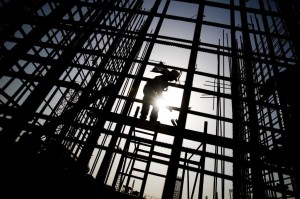Below is an interview we conducted with Matilde Gattoni, a photojournalist who has spent a year documenting the living and working condition of migrant construction workers in the UAE. A gallery of the amazing photos can be seen on her site.
First, could you introduce yourself to our readers?
I’m a photojournalist, my work focuses on water issues around the world, due to war, drought, desertification, natural and ecological disasters. I’m based in the UAE and work in the whole MENA territory for some of the best European and US magazines such as NY Times, Time, Der Spiegel, Le Monde, Financial Times, Bloomberg...
What prompted you to document the living and working condition of migrant workers in the UAE? How long did you spend following those workers?

I live in Dubai so I was aware of the situation. I spent more or less one year following their daily life on the construction sites and in the labour camps.
Could you tell us about what you witnessed in the UAE? What image made the strongest impression on you?
I witnessed the miserable conditions in which the workers live. I started taking pictures inside the construction sites as I was working on a regular basis for a few property builders, I had easy access and was spending hours documenting the working conditions. From there I decided to go deeper and discover the other side of their life. Every evening, the hundreds of thousands of young men who build Dubai are bussed from their sites to a vast concrete wasteland an hour out of town, where they are quarantined away. Sonapur is a rubble-strewn patchwork of miles and miles of identical concrete buildings. Some 300,000 men live piled up here, in a place whose name in Hindi means "City of Gold". There, workers have to share a tiny room between 6/8 people without a/c, their few belongings are hanged on the wall as there are no closets, they brush their teeth in the shower as there are no wash basin, the food as well is washed in the shower, water is not properly desalinated so workers get easily sick.

I will never forget when an Indian worker died in front of me last year. I was on a construction site in Abu Dhabi, a worker hurt himself, he had blood all over his head and the ambulance was too far so they started carrying him away but by the time we reached the ambulance he had lost too much blood and passed away.
How do you think photography can help in exposing and raising awareness about the conditions workers endure in the UAE?
Photography can have a huge impact on people and sometimes government. Things started to slowly change in the UAE a few years back when National Geographic published an article on Dubai, witnessing the working and living conditions of the blue collars for the first time. The UAE felt compelled to give the workers 3 hours lunch break in the summer, because of the heat, and the labour camps that were built after that were definitely better. But this is not enough.
How did you manage to enter labor camps of the construction workers in the UAE? It's a known fact that many journalists and film crews were prevented from entering and documenting the living conditions of migrant workers.

I just sneaked in and I had a good fixer. I was being rejected most of the times, they called the police, so I was just going from one camp to another, trying my luck.
What would you want Emiratis to know about the people who are building their skyscrapers?
I would like them to look at the images and think, what if it was me?
Were you able to get close to the workers as you documented their lives for a year? Did they share their outlook about their conditions?
Yes, very close, I had a fixer so I could interact with them, I was spending hours in their rooms, having lunch with them, watching them shower, brush their teeth, sleep. They shared their sorrow, their sadness for being trapped in hell.




![Image relating to [Stories of Origin] Indian fishermen: Between the devil and the deep sea](https://www.migrant-rights.org/wp-content/uploads/2018/12/Screen-Shot-2018-12-27-at-10.35.49-AM.png)